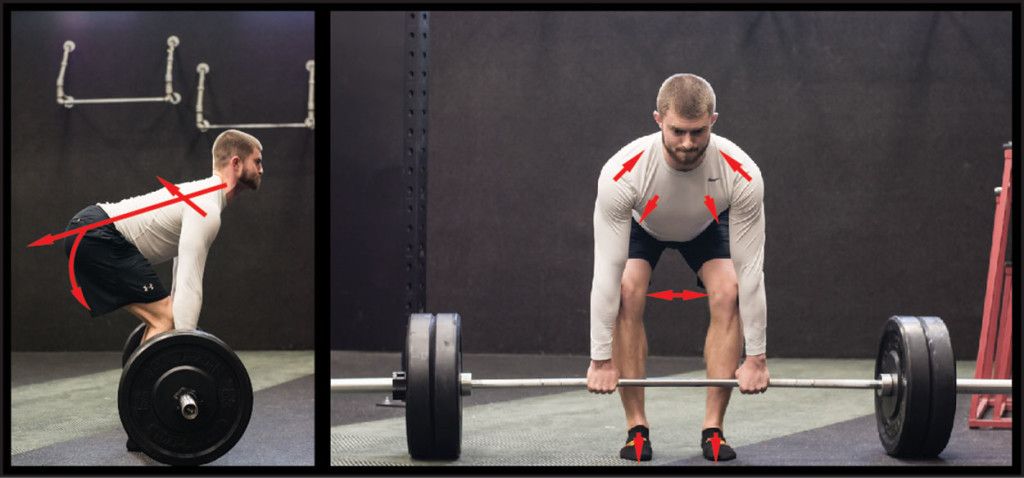Catch up on part 1 and part 2 of this series if you missed them.
How To Deadlift
I’ll admit writing this particular blog has been difficult. Trying to describe how to do an exercise with only words is challenging. Especially an exercise that seems so simple yet has so many finer points, like the deadlift. I am usually able to demonstrate this exercise in person, then coach my clients step by step on these finer points. I can use any number of verbal or physical cues based on what I see my client doing right there in front of me.
So, this article will outline how to do a perfect deadlift; however, I won’t be there to tell you if you’re doing it correctly, so use your own good judgement.
A Deadlift Is Not A Squat
I want to start talking about the deadlift by talking about the squat. The squat and the deadlift are very similar in that they both work every major muscle group in your legs, core, and posterior chain (everything on the back half of your body). In fact, many people think the deadlift is just squatting a weight that starts on the floor instead of it resting on their shoulders.
A squat and a deadlift are very similar but it is the subtle differences that are most important. They are two different and essential basic human movements.
A squat is primarily vertical motion; everything lowers then rises together. You start the exercise already loaded, descend into the bottom further loading the muscles, then rise out of it.
A deadlift is primarily horizontal. The emphasis is on the hinging back in your hips to get down and as you stand up thrusting your hips through. Since the weight starts on the ground the exercise starts unloaded and you have to create power from a dead stop.
While the muscle groups worked are very similar, how they are worked and what percentage of each specific muscle worked within the groups is very different.
I mention this up front because the major mistake people make when deadlifting is squatting the weight off the floor. As you go through this article and start deadlifting on your own, be aware of the differences and appreciate them.
Now on to deadlifting!
Deadlift: The Setup
As with most things in life, having a good setup will make everything else much easier. There are two main styles of deadlifting: conventional and sumo. I’ll only be covering conventional here but all of the principles also apply to sumo.
If you start standing at the bar and let your arms hang by your side, your feet should be mostly straight and directly under your hips, inside of shoulder width apart. Your legs from the top of your femur to your ankle should be perfectly straight lines. For an average person that means about 6-10 inches between your feet.
Start to lower to the bar by keeping your spine long, tipping your hips back and pushing your butt back towards the wall behind you. Keep pushing your butt back and your knees will start to bend naturally. When your hands reach the bar your back and neck should be a straight line from your tailbone to the top of your head. When viewed from the side your hips should only be slightly lower than your head and your shins should be nearly vertical.
Grab the bar with your hands directly under your shoulders. Again, these should be almost perfectly straight lines. Seeing a theme?
I suggest starting with a double overhand grip, meaning both palms facing back towards you until you progress past being able to hold on to the bar. When the weight gets too heavy flip one hand so one palm is facing towards you and one is facing away. Last, roll the bar back towards you nearly touching your shins.
So now you’re in position but the setup isn’t quite done yet!
Deadlift: Building Tension (Setup Part 2)
Before the lift starts, it is important to build tension, both within your body and against the bar. This is often called “pulling the slack out of the bar.” This part is very important both for safety and for achieving a heavier lift – imagine all your muscles loose and you jerk up and try to lift 315+ lbs… it won’t end well.
You’re already in position with your hands on the bar: now grab the ground with your feet. Push your knees out, engaging your glutes. Roll your shoulders back and down away from your ears while at the same time squeezing the bar as hard as you can. Get a big breath in deep into your belly and pull up against the weight while at the same time wedging your hips down slightly. Think about pulling yourself down, trying to wedge yourself between the bar and the floor. You should feel about every muscle in your body engaged at this point; nothing should be loose.
Deadlift: The Push
If you watch a deadlift, it looks like someone pulling a weight off the floor, which it technically is. I use the term “Push” here on purpose though. In your mind, when you start the lift, think of pushing the ground away from you as opposed to lifting the weight off the ground with your upper body.
Remember to keep all that tension we built in part 2. When viewing the start of the lift from the side, you don’t want to see the hips shoot up or the upper body jerk. The bar should move in a smooth vertical motion, traveling as close as possible to the shins until the knees. As the bar passes the knees, the hips should start thrusting towards the bar and the bar should continue vertically, close to the thighs. If you did the first two phases correctly this should be the easy part (other than lifting all that weight).
Deadlift: The Lockout
At the top your whole body should be tight. Quads engaged, glutes pinched and slightly tucked under, abs tight (not sticking out), lats tight.
Deadlift: Lowering The Weight
Now the lift is complete! To return the weight to the floor, start by hinging your hips back. The weight should travel directly down, not getting away from your thighs or shins on the descent.
Deadlift: Overview
- Stand at the bar, set your feet, get tall, take a few breaths, and relax
- Hinge your hips back keeping your spine long until you can grab the bar
- Squeeze the bar, pull your shoulders back and down, open your chest, open your knees, Wedge your hips down pulling slack out of the bar
- Breathe in deep into your lower abs and tighten your abs
- Without losing slack, drive your feet into the ground pressing the ground away
- As the bar passes your knees, drive your hips towards the bar, contracting your glutes until you are all the way locked out
- Reverse the movement, hinging your hips back and lowering the bar, keeping it close to your thighs, then close to your shins
- Completely reset before the next one!
Deadlifting Program
Deadlifting is incredibly important for any athlete, including golfers. I suggest deadlifts of some variety a couple times a week. Start light and progressively work heavier through the weeks. The goal for all my golfers is a one repetition maximum of 1.5x-2x bodyweight.
Don’t forget to include single leg deadlifts in your programming as well!
Are you ready to play your best through
effective, focused, and proven training?
Now offering in-person and online training. Contact me now to schedule your
complimentary golf specific movement evaluation.

Ryan Blackburn is the owner of Orlando Golf Performance in Orlando, FL. He works with golfers on every major tour as well as college and amateur players. He holds multiple certifications in the field of functional movement and athletic performance.



